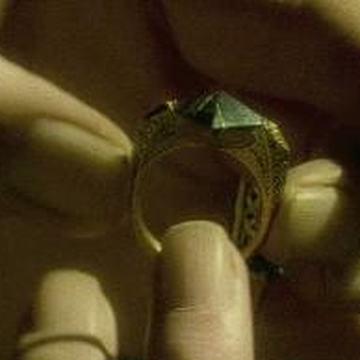
MANUFACTURER
Death or the Peverell brothers
MADE
13th century
USAGE
Cloak, Stone and Wand
OWNERS
Ignotus Peverell (the cloak) †
Cadmus Peverell (the stone) †
Antioch Peverell (the wand) †
Generations of Peverells
James Potter I (the cloak) †
Harry Potter (all)
Draco Malfoy (the wand)
Albus Dumbledore (all) †
Emeric the Evil (the wand) †
Egbert the Egregious(the wand) †
Godelot (the wand) †
Hereward (the wand) †
Barnabas Deverill (the wand) †
Loxias (the wand) †
Arcus and/or Livius (the wand) †
Gregorovitch (the wand) †
Gellert Grindelwald (the wand) †
Marvolo Gaunt (the stone) †
Morfin Gaunt (the stone) †
Tom Marvolo Riddle (the stone and the wand) †
[Source]
"Point me!" This article is about the three legendary objects. You may be looking for the novel, Part 1 or Part 2 of the film, Part 1 or Part 2 of the soundtrack, Part 1 or Part 2 of the video game or Part 1 or Part 2 of the video game soundtracks of the same name.
The Elder Wand," he said, and he drew a straight vertical line on the parchment. "The Resurrection Stone," he said, and he added a circle on top of the line. "The Cloak of Invisibility," he finished, enclosing both line and circle in a triangle, to make the symbol that so intrigued Hermione. "Together," he said, "the Deathly Hallows.XENOPHILIUS LOVEGOOD
The Deathly Hallows are three highly powerful magical objects supposedly created by Death and given to each of three brothers in the Peverell family. They consisted of the Elder Wand, an immensely powerful wand that was considered unbeatable; the Resurrection Stone, a stone which could summon the spirits of the dead, and the Cloak of Invisibility, which, as its name suggests, renders the user completely invisible. According to the story, both Antioch Peverell(owner of the Wand) and Cadmus Peverell(owner of the Stone) came to bad ends. However, Ignotus Peverell's wisdom in requesting the Cloak was rewarded.
According to legend, he who possesses these three artefacts would become the Master of Death. Dumbledore told Harry that he and another wizard, Gellert Grindelwald took this to mean that the uniter of the Deathly Hallows would be invincible. The story of the Deathly Hallows was originally told by Beedle the Bardand subsequently passed from family to family as a wizard fairytale. Few wizards ever realised that the Deathly Hallows were genuine items. Most people thought that there were things that Beedle had made up to entertain young wizards and witches.
No one but Harry Potter has been known to have been in command of all three at the same time, though he was never in possession of them all at once (he dropped the stone in the Forbidden Forest just before gaining the wand that he had won the alliance of in a previous scuffle at Malfoy Manor). Albus Dumbledore had possessed all three, but not all at once, similar to Harry, but he was never the true owner of the Cloak.
History
Origin of the Hallows
The Tales of Beedle the Bard
That is a children's tale, told to amuse rather than to instruct. Those of us who understand these matters, however, recognise that the ancient story refers to three objects, or Hallows, which, if united, will make the possessor Master of Death.XENOPHILIUS LOVEGOOD'S OVERVIEW OF THE HALLOWS
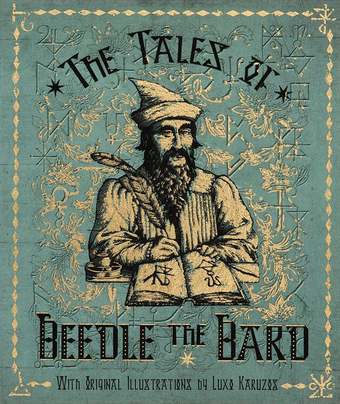
In The Tales of Beedle the Bard the authorpresented his own version of the origin of the Hallows. Hundreds of years ago, the three Peverell brothers were travelling at twilight, and reached a river too dangerous to cross. The three brothers, being trained in the magical arts, simply waved their wands and created a bridge across the river. They were then stopped by Death himself, who felt cheated that they had gotten across the river, as most travellers drowned in it.
Death, a cunning liar, then pretended to congratulate them on being clever enough to evade him, and offered each of them a powerful magical item. The first brother, Antioch Peverell, wished to have the most powerful wand out of his combative personality; Death broke a branch off a nearby elder tree and created for him the Elder Wand, a wand more powerful than any other in existence. The second brother, Cadmus Peverell, out of arrogance, wanted to humiliate Death even further, and wished to have the power to bring loved ones from the grave; Death then took a stone from the riverbed and created for him the Resurrection Stone, a stone capable of bringing the dead back to the living world. The third brother, Ignotus Peverell, who was a humble man, did not trust Death and asked to go on from the river without being followed by Death; Death then gave him his own Cloak of Invisibility, an invisibility cloak that never lost its power through curses or age.
The three legendary objects, (the cloak, the wand and the stone) together make up the Deathly Hallows.
Dumbledore's Theory
I think it more likely that the Peverell brothers were simply gifted, dangerous wizards who succeeded in creating those powerful objectsALBUS DUMBLEDORE'S SPECULATION
Instead of being rewards for their cleverness, the Deathly Hallows were actually part of a cunning plan by Death to kill off the Peverellsso he could take them for his own.
However, Albus Dumbledore felt that it was more likely that the Hallows were actually created by the very talented and powerful brothers, and that the story of their origins as objects fashioned by Death sprang up around them as result of the powers they possessed.
Movement of the Hallows
Antioch's murder
So the oldest brother, who was a combative man, asked for a wand more powerful than any in existence: a wand that must always win duels for its owner, a wand worthy of a wizard who had conquered Death!ANTIOCH PEVERELL RECEIVING THE ELDER WAND
 Antioch's throat is slit in his sleep
Antioch's throat is slit in his sleep
In time, the brothers went their separate ways. Antioch Peverell travelled to a wizarding village where he killed a wizard he had once duelled with, he then boasted of the power of the Elder Wand, that it was unbeatable and in his possession, invoking envy amongst the many wanting to possess it for themselves. His throat was slit in his sleep by another wizard who stole the Elder Wand.[1]
Cadmus' suicide
Then the second brother, who was an arrogant man, decided that he wanted to humiliate Death still further, and asked for the power to recall others from Death.CADMUS PEVERELL RECEIVING THE STONE
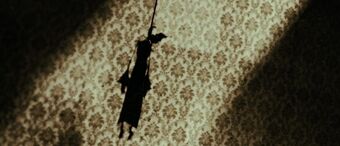 A heartbroken Cadmus commits suicide
A heartbroken Cadmus commits suicide
Cadmus travelled back home and used the Resurrection Stone to bring back the woman he loved, but was dismayed to find that it was only a pale imitation of her: the dead did not belong in the living world and could not truly be brought back. He found that she was cold, lifeless, and miserable in the land of the living, nothing like she used to be. In the end Cadmus committed suicide by hanging himself so he could truly join her.[1]
Ignotus' passing and unusual friend
It was only when he had attained great age that the youngest brother finally took off the Cloak of Invisibility and gave it to his son.IGNOTUS PEVERELL PASSING ON THE CLOAK
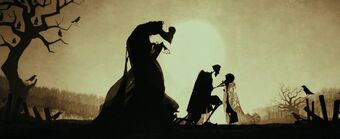 Ignotus passes the cloak down to his son
Ignotus passes the cloak down to his son
Ignotus used the cloak to remain hidden from Death for a long time. When he was an old man, he passed the cloak onto his son, greeted Death as an old friend, and went with him to the next world.[1]
The cloak continued to be passed down through the descendants of the Peverells(although the name became extinct in the male line). The wand passed from wizard to wizard, nearly always by the murder of its previous owner. The wand, during its passing from wizard to wizard, has been called "The Death Stick" and the "Wand of Destiny". On an interesting note, no witch is ever stated to have held possession of the wand. The stone was also passed down through the Peverells' descendants. It eventually ended up in the possession of the House of Gaunt, and was later stolen by Tom Marvolo Riddle, neither Tom nor Marvolo Gaunt were aware of the powers of the stone, nor that it was a Hallow. Marvolo was solely concerned with the "noble origins" of the stone, made into a ring, and thought that the Hallows symbol on it was the family coat of arms. Lord Voldemort could not have been aware of the stone's true origin either, as he transformed the stone into a Horcrux.
Quests for Hallows
The Hallows played a particularly important role in the lives of Albus Dumbledore, Gellert Grindelwald, and Harry Potter.
Albus Dumbledore and Gellert Grindelwald
I was fit only to possess the meanest of them, the least extraordinary. I was fit to own the Elder Wand, and not to boast of it, and not to kill with it. I was permitted to tame and to use it, because I took it, not for gain, but to save others from it.ALBUS DUMBLEDORE ON THE DEATHLY HALLOWS AND THE ELDER WAND
 A young Albus Dumbledore and Gellert Grindelwald
A young Albus Dumbledore and Gellert Grindelwald
In his youth, Albus Dumbledore, along with soon-to-become Dark Wizard Gellert Grindelwald, entertained dreams of finding and appropriating the Hallows for himself. This quest for power also manifested itself in his vision of a future where wizards would rule over and control Muggles "for the greater good". A family argument later caused him to revise and reconsider his beliefs after the death of his sister.[2] Up until his death, he never trusted himself with power, refusing the post of Minister for Magic three times - yet his yearning to find the Hallows never left him.
After his sister Ariana died, Dumbledore sought out the Resurrection Stone in the hopes that finding it would somehow revive his dead sister and parents. Thus when he chanced upon it sometime in 1996, when it had already been turned into a Horcrux by Voldemort, the temptation proved too much to handle and he put on the ring, invoking a terrible curse Voldemort had placed which caused his right hand to wither and die. Only when the Horcrux was destroyed by Godric Gryffindor's Sword did the stone revert to its normal state, with its original powers intact. Dumbledore also came into possession of the Cloak of Invisibility when he borrowed it from its owner, James Potter, a descendant of Ignotus Peverell. It was he who passed the Cloak on to James' son, Harry, to whom it proved to be a useful tool in defeating Voldemort and his allies. He also gave to Harry the Resurrection Stone, by means of the Snitch Harry had caught in his first ever Quidditch match.
During a holiday spent with his aunt at Godric's Hollow, Gellert Grindelwald met Albus Dumbledore, and with him he sparked his desire for the Hallows.[2]
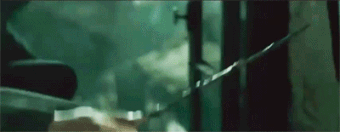 Grindelwald gains possession of the Elder Wand by stealing it from wandmaker Gregorovitch
Grindelwald gains possession of the Elder Wand by stealing it from wandmaker Gregorovitch
In his later life, Grindelwald gained possession of the Elder Wand by stealing it off the foreign wandmaker known as Gregorovitch. Upon duelling Dumbledore sometime in the 1940s, Grindelwald lost, along with the possession of the wand. Decades later, in 1998, Lord Voldemort attempted to acquire the wand by visiting Grindelwald at his cell in Nurmengard. However, Grindelwald denied ever possessing the wand, and was murdered by Lord Voldemort.
Harry Potter
It's never occurred to me before, but I've heard stuff about charms wearing off cloaks when they get old, or them being ripped apart by spells so they've got holes in. Harry's was owned by his dad, so it's not exactly new, is it, but it's just... perfect!RON WEASLEY REGARDING HARRY POTTER'S CLOAK OF INVISIBILITY
Upon hearing the Tale of the Three Brothers, Harry Potter wished to unite the Hallows to become the Master of Death and ultimately defeat Lord Voldemort. He ultimately dismissed this idea however, as he knew that the late Albus Dumbledore wished for him to destroy the Horcruxes in order to beat the Dark Lord. Harry did possess each of the Hallows eventually, for a brief moment of time.[2]
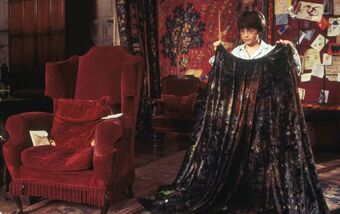 Harry Potter receiving the Cloak of Invisibility on Christmas Day
Harry Potter receiving the Cloak of Invisibility on Christmas Day
Without realising it, Harry Potter possessed one of the Hallows from the age of 11, the Cloak of Invisibility. The Cloak was rightfully his, and should have been passed down to him from his father, James Potter, had he not been murdered. Harry is a living descendant of the third brother, Ignotus Peverell.
Upon his death, Albus Dumbledore left the Resurrection Stone to Harry in his will. It was disguised inside a Snitch, the first one Harry had ever caught in a Quidditch match.[3] On the Snitch was engraved the words I open at the close. Harry figured out later that in order to open it, he had to be close to death. To open the Snitch, he said "I'm about to die," and touched it to his mouth because he had caught it with his mouth. This was before confronting Lord Voldemort and his Death Eaters in the Forbidden Forest during the Battle of Hogwarts.
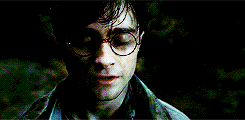 Harry temporarily brings back his family and friends
Harry temporarily brings back his family and friends
Harry used it to "bring back" and talk to his mother, his father, Remus Lupin, and his godfather, Sirius Black. Harry dropped the Stone later in the forest,[2] and never told anyone (besides Dumbledore's portrait) so that nobody would seek it. In a recent interview, Rowling said she would like to believe that a centaur's hoof pushed it into the ground, burying it forever. Without realising until later, Harry became the master of the Elder Wand when he defeated Draco Malfoy during the Battle of Malfoy Manor in 1998. The wand recognised him as its master when Harry duelled Lord Voldemort during the Battle of Hogwarts, even though Harry had never even touched it before. Harry did not want the wand, he only used it to repair his thence broken Holly and Phoenix feather wand.[2]
Once this deed was accomplished, Harry replaced the wand in the tomb of Albus Dumbledore. His mindset was that if he could die of natural causes without passing the wand to an heir, the wand's power, and, therefore, its history of bloodshed, would be gone forever.
Current whereabouts
The Elder Wand
I’m putting the Elder Wand back where it came from. It can stay there. If I die a natural death like Ignotus, its power will be broken, won’t it? The previous master will never have been defeated. That’ll be the end of it.HARRY ON HIS DECISION TO GIVE UP THE ELDER WAND
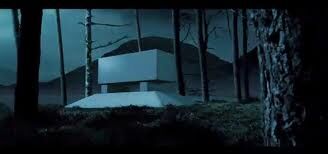 The White tomb, final resting place of Albus Percival Wulfric Brian Dumbledore
The White tomb, final resting place of Albus Percival Wulfric Brian Dumbledore
As Harry Potter had no intention of using the Elder Wand for his own purposes (having achieved his goal of defeating Voldemort), he only used it to restore his own broken wand. He then at an unknown date returned the Elder Wand to the grave of Albus Dumbledore, located on the grounds of Hogwarts, supposing that, if he died of natural causes, its power would finally be broken, and its history of blood and violence along with it.
The wand has a different fate in the films, where Harry snaps the wand in half and throws it off the gorge saying that he doesn't want it.
The Resurrection Stone
The thing that was in the Snitch. I dropped it in the Forest. I don't know exactly where, but I'm not going to go looking for it again.HARRY'S DECISION REGARDING THE STONE
 Harry discarding the stone
Harry discarding the stone
After Harry turned the stone over in his hand thrice, and was immediately joined by the shades of his parents, Sirius Black, and Remus Lupin, he discarded the Resurrection Stone. It was lost somewhere in the Forbidden Forestnear Aragog's lair, where Harry intended it to remain. J. K. Rowling later revealed that a centaur pressed it into the ground by stomping on it as the herd charged to help the defenders of Hogwarts in the fight against Voldemort and his Death Eaters.
The Cloak of Invisibility
Harry Potter and the Deathly HallowsHARRY POTTER'S DECISION TO KEEP THE CLOAK OF INVISIBILITY
As for the Cloak of Invisibility, Harry remarked to Dumbledore's portrait that he would be keeping it for himself and his family [HP7]; it is most likely still with him to this day and probably passed it down to one of his children. As of The Cursed Child, James Sirius Potter owns the Invisibility Cloak.
Masters of Death
 By having mastered the three Hallows one will become "Master of Death"
By having mastered the three Hallows one will become "Master of Death"
Harry Potter is the only known Master of Death, having gathered and mastered all three Hallows and most importantly, accepted death, as the true master understands that death is inevitable and that there are worse things in life than dying. He did not unite all three of them physically at the same moment, as he possessed no more than two at the same time. Albus Dumbledore had also gathered all three, though physically owning no more than two at the same time, and did not master the usage of the Cloak, but he could qualify for the title of the Master of Death as he fulfilled the most important criteria needed by accepting death due to understanding that death is inevitable and there are worse fate than dying. With the Stone lost, it is unlikely there will ever be another.
Thank you
Citation:
https://harrypotter.fandom.com/wiki/Deathly_Hallows
















